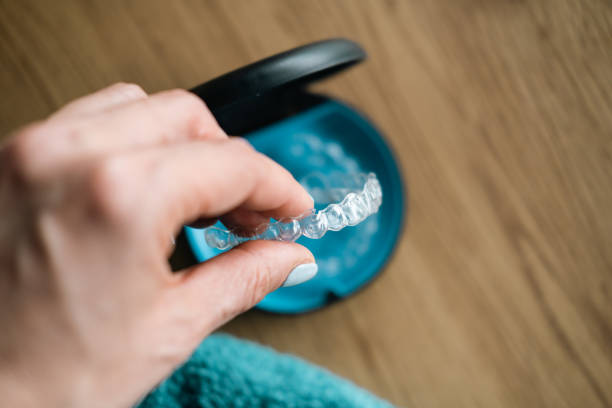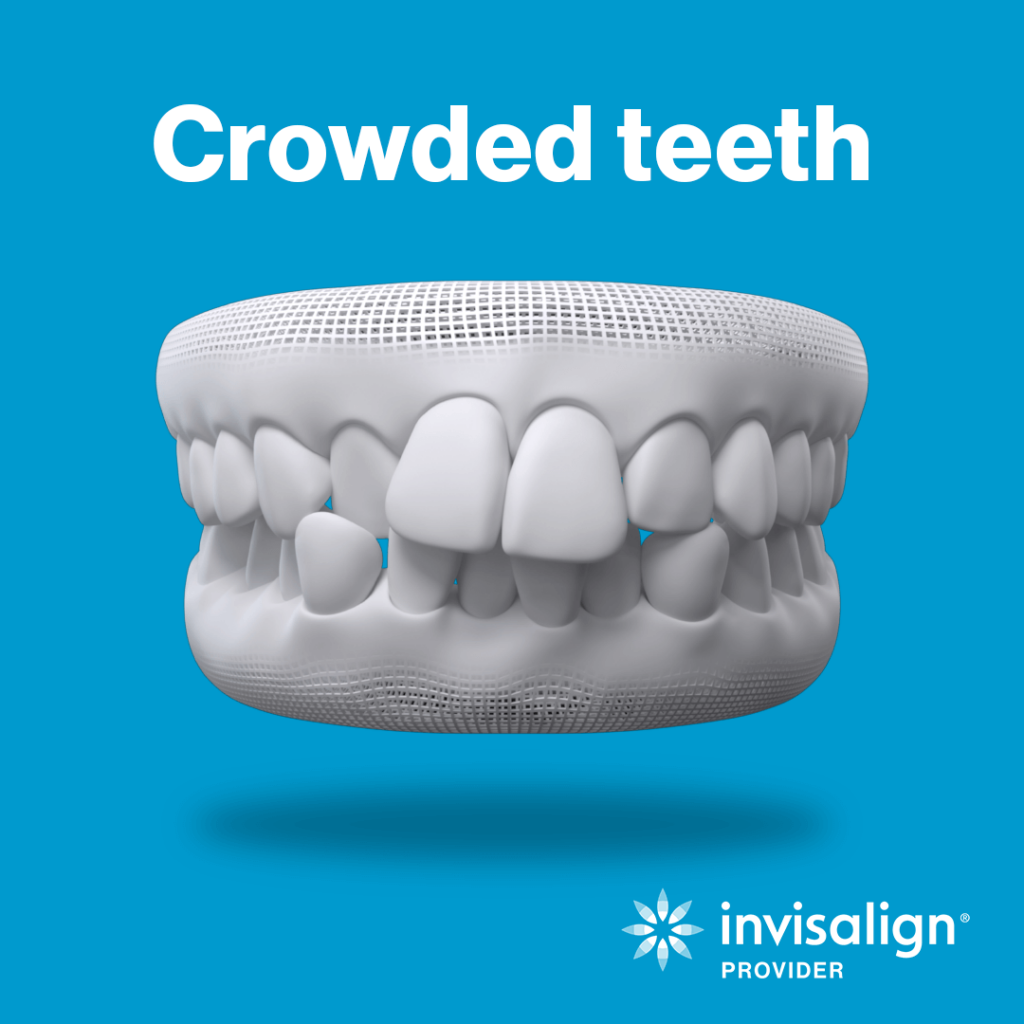Are crowded teeth making you feel self-conscious about your smile? You’re not alone. Overcrowded teeth can lead to oral health issues and affect your self-esteem. The good news is that Invisalign, in most cases, can treat crowded teeth and offers a highly effective solution without the need for traditional metal braces. With your Fairview dentist at Sloan Creek Dental, we’ll explore what causes this condition, the benefits of Invisalign, and whether this type of aligner treatment is the right choice for you.

The symptoms of crowded teeth can vary from one individual to another and may impact your oral health and self-esteem. These symptoms include:

Crowded teeth, a typical orthodontic issue, are simply when there isn’t enough room for all your teeth to fit normally in your mouth, resulting in overlapping and twisting. This condition might make you feel self-conscious or uneasy about your smile. So, what causes crowded teeth? Several factors can contribute to this condition:
Taking care of our personal health is important, but often we forget about our smiles. However, did you know that crowded teeth can affect more than just your appearance? If you’re looking for a solution to fix crowded teeth, Invisalign could be a great option for you. Here are some of the benefits you can expect from using Invisalign for crowded teeth.
Fixing crowded teeth with Invisalign involves a multi-step process:
The treatment time to fix crooked teeth with Invisalign can vary depending on the complexity of your case. On average, achieving a beautifully aligned smile takes about 12 to 18 months. However, some individuals may see results in a shorter period, while more intricate cases might extend the treatment timeline to approximately 24 months.
The key to success is consistent wear – you should keep your Invisalign clear aligners on for 20-22 hours each day, only removing them for eating and oral hygiene. Routine check-ups with your orthodontist are essential to ensure your progress aligns with your treatment plan. While the exact timeline is unique to each person, the result is always worth it – a healthier, more confident you, with a straighter smile to show. Ultimately, your Invisalign journey may have its own timeframe, but the destination remains the same – a smile you’ll be proud of.
Many people opt for Invisalign over traditional braces for several reasons:
When it comes to straightening teeth, Invisalign is a highly effective treatment. In many cases, it can be just as effective as traditional braces, especially for mild to moderate crowding, spacing, and bite issues. Invisalign has the advantage of being almost invisible, removable for eating, and more comfortable, with fewer food restrictions.
However, deciding between Invisalign and braces will depend on your orthodontic needs. Conventional braces may still be preferred for severe cases, as they offer more control over complex tooth movements. Ultimately, your orthodontist or dentist will evaluate your unique situation and recommend the best option for achieving the desired results.
Invisalign can address a wide range of alignment issues, including gaps between teeth, bite misalignments like overbites, underbites, open bites, crossbites, and crooked teeth.
Preventing teeth from moving after Invisalign treatment involves:
Depending on the severity of overcrowding, an alternative treatment option may be necessary. Your dentist will provide recommendations during your office visit to find the best way to straighten your teeth.
Maintaining oral hygiene with Invisalign for crowding is essential. Here’s how:

If crowded teeth have left you feeling self-conscious or concerned about your oral health, Invisalign offers an innovative and effective solution that can truly transform your smile. By understanding the causes and symptoms of crowded teeth, you’re already on the path to making an informed decision about your orthodontic treatment.
At Sloan Creek Dental, we’re here to guide you through your Invisalign treatment process, from your initial visit to your final appointment. If you’re in the Fairview or Allen area and would like a beautiful smile, contact us at our Fairview, TX dental office to schedule your initial consultation at 972-468-1440.
We firmly believe that the internet should be available and accessible to anyone, and are committed to providing a website that is accessible to the widest possible audience, regardless of circumstance and ability.
To fulfill this, we aim to adhere as strictly as possible to the World Wide Web Consortium’s (W3C) Web Content Accessibility Guidelines 2.1 (WCAG 2.1) at the AA level. These guidelines explain how to make web content accessible to people with a wide array of disabilities. Complying with those guidelines helps us ensure that the website is accessible to all people: blind people, people with motor impairments, visual impairment, cognitive disabilities, and more.
This website utilizes various technologies that are meant to make it as accessible as possible at all times. We utilize an accessibility interface that allows persons with specific disabilities to adjust the website’s UI (user interface) and design it to their personal needs.
Additionally, the website utilizes an AI-based application that runs in the background and optimizes its accessibility level constantly. This application remediates the website’s HTML, adapts Its functionality and behavior for screen-readers used by the blind users, and for keyboard functions used by individuals with motor impairments.
If you’ve found a malfunction or have ideas for improvement, we’ll be happy to hear from you. You can reach out to the website’s operators by using the following email
Our website implements the ARIA attributes (Accessible Rich Internet Applications) technique, alongside various different behavioral changes, to ensure blind users visiting with screen-readers are able to read, comprehend, and enjoy the website’s functions. As soon as a user with a screen-reader enters your site, they immediately receive a prompt to enter the Screen-Reader Profile so they can browse and operate your site effectively. Here’s how our website covers some of the most important screen-reader requirements, alongside console screenshots of code examples:
Screen-reader optimization: we run a background process that learns the website’s components from top to bottom, to ensure ongoing compliance even when updating the website. In this process, we provide screen-readers with meaningful data using the ARIA set of attributes. For example, we provide accurate form labels; descriptions for actionable icons (social media icons, search icons, cart icons, etc.); validation guidance for form inputs; element roles such as buttons, menus, modal dialogues (popups), and others. Additionally, the background process scans all of the website’s images and provides an accurate and meaningful image-object-recognition-based description as an ALT (alternate text) tag for images that are not described. It will also extract texts that are embedded within the image, using an OCR (optical character recognition) technology. To turn on screen-reader adjustments at any time, users need only to press the Alt+1 keyboard combination. Screen-reader users also get automatic announcements to turn the Screen-reader mode on as soon as they enter the website.
These adjustments are compatible with all popular screen readers, including JAWS and NVDA.
Keyboard navigation optimization: The background process also adjusts the website’s HTML, and adds various behaviors using JavaScript code to make the website operable by the keyboard. This includes the ability to navigate the website using the Tab and Shift+Tab keys, operate dropdowns with the arrow keys, close them with Esc, trigger buttons and links using the Enter key, navigate between radio and checkbox elements using the arrow keys, and fill them in with the Spacebar or Enter key.Additionally, keyboard users will find quick-navigation and content-skip menus, available at any time by clicking Alt+1, or as the first elements of the site while navigating with the keyboard. The background process also handles triggered popups by moving the keyboard focus towards them as soon as they appear, and not allow the focus drift outside of it.
Users can also use shortcuts such as “M” (menus), “H” (headings), “F” (forms), “B” (buttons), and “G” (graphics) to jump to specific elements.
We aim to support the widest array of browsers and assistive technologies as possible, so our users can choose the best fitting tools for them, with as few limitations as possible. Therefore, we have worked very hard to be able to support all major systems that comprise over 95% of the user market share including Google Chrome, Mozilla Firefox, Apple Safari, Opera and Microsoft Edge, JAWS and NVDA (screen readers), both for Windows and for MAC users.
Despite our very best efforts to allow anybody to adjust the website to their needs, there may still be pages or sections that are not fully accessible, are in the process of becoming accessible, or are lacking an adequate technological solution to make them accessible. Still, we are continually improving our accessibility, adding, updating and improving its options and features, and developing and adopting new technologies. All this is meant to reach the optimal level of accessibility, following technological advancements. For any assistance, please reach out to